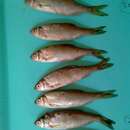Diagnostic Description
provided by Fishbase
Leucos basak is distinguished from other congeners by the following characters: moderate size, usually 12.0-14.0 cm SL; lack of a mid-lateral band; body uniformly silvery in life; peritoneal membrane black; usually 36-38 pored scales on lateral line (vs. 38-43 in the other congeners). It differs from Leucos aula by the absence of lateral band and black peritoneal membrane (vs. silvery in L. aula); from L. panosi and L. ylikiensis mainly by having usually 9-10 gill rakes (vs. 18-20 in L. ylikiensis and 13-14 in L. panosi). Leucos basak is most closely related to L. albus based on molecular analyses but differs from this species by having 36-38 scales on lateral line (vs. usually 41-42 in L. albus); 9 branched dorsal rays (vs. 8 in L. albus); and blackish peritoneal membrane (vs. nearly silvery in L. albus) (Ref. 96829).
Morphology
provided by Fishbase
Dorsal soft rays (total): 11; Analsoft rays: 11
Biology
provided by Fishbase
Occurs in a wide range of habitats such as warm streams and rivers with moderate to slow current, lakes, backwaters, swampy areas, and artificial water bodies (Ref. 59043). Sympatric with Leucos albus in Lake Skadar (Ref. 96829). Feeds on plankton and plant material. Spawns over gravel and stones and in flooded areas and lakes. Eggs are sticky, yellow-orange which hatch in 9 days at 13-17°C (Ref. 59043).
Rutilus karamani: Brief Summary
provided by wikipedia EN
Leucos basak, the Albanian roach, Dalmatian roach or Croatian roach, is a species of freshwater fish in the family Cyprinidae. It is found in Albania, Bosnia and Herzegovina, Croatia, and Serbia and Montenegro.
Its natural habitats are intermittent rivers and freshwater lakes.
- license
- cc-by-sa-3.0
- copyright
- Wikipedia authors and editors

